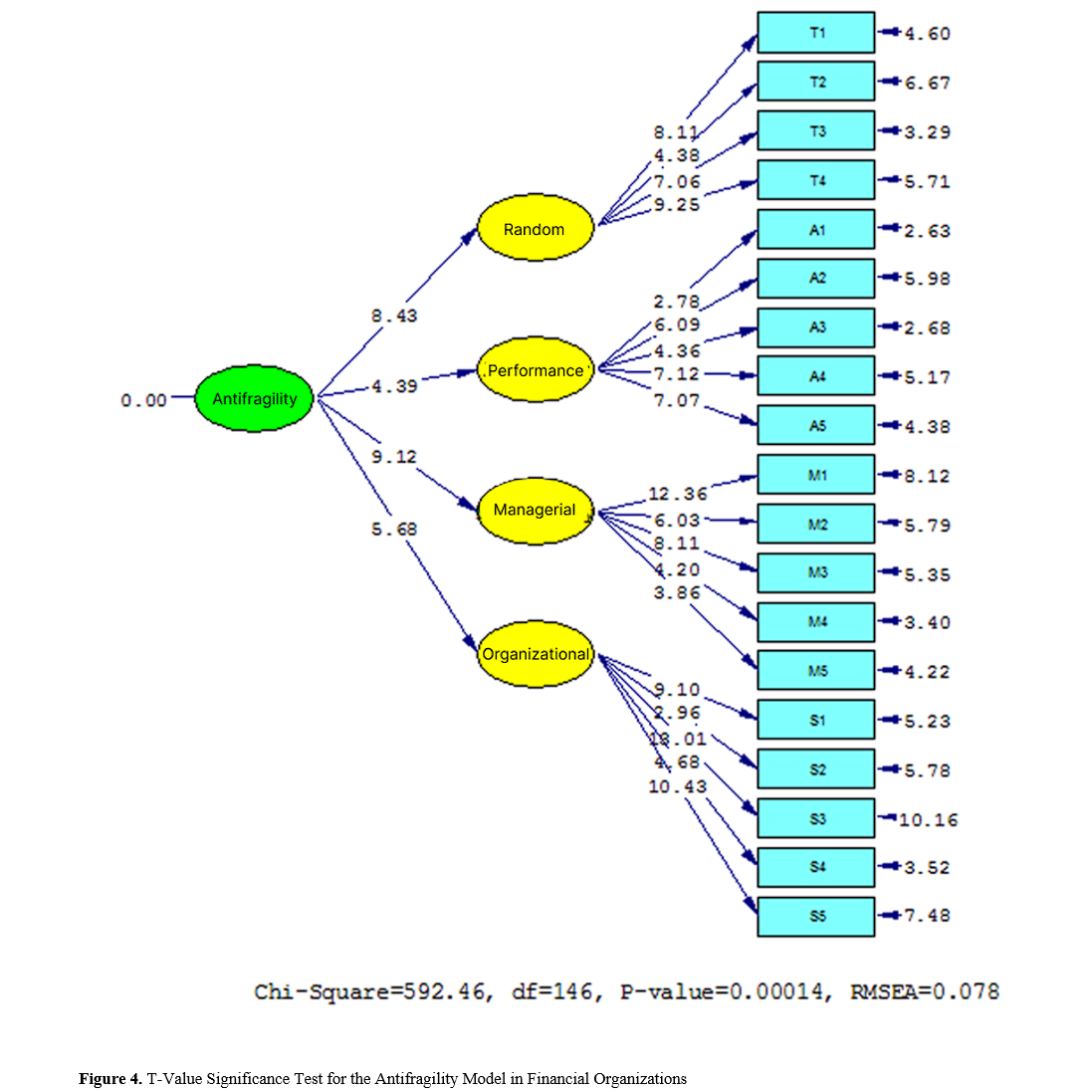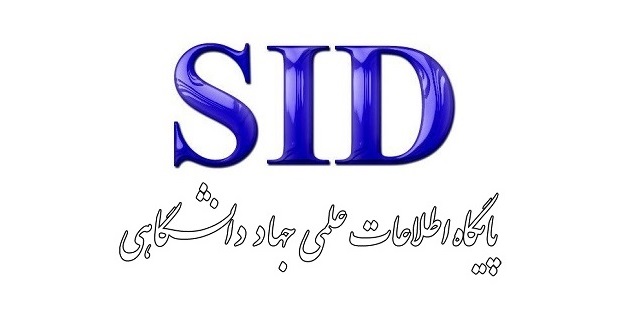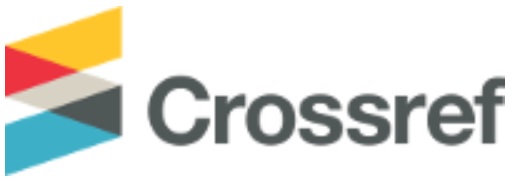Fitting the Antifragility Model in Iranian Financial Organizations Through Confirmatory Factor Analysis
Keywords:
Antifragility, financial organizations, confirmatory factor analysisAbstract
This study was conducted to fit the antifragility model in Iranian financial organizations. The research method was quantitative, utilizing a correlational and descriptive approach. The statistical population comprised managers and experts from financial organizations in the northwest of Iran, totaling 488 individuals. Using Cochran’s formula, a sample size of 208 participants was selected. The validity of the research instrument was confirmed through consultation and guidance from academic advisors, while its reliability was verified with a Cronbach’s alpha coefficient above 0.7. Descriptive statistics were employed to describe demographic indicators, and inferential statistics were used for quantitative model analysis through confirmatory factor analysis, utilizing SPSS 25 and Lisrel 8.8 software. Statistical analysis was conducted on 19 components categorized into four groups: (1) the random and environmental category, which included the components of flexibility, financial crisis, resilient performance, agility, and adaptability; (2) the financial performance category, which included the components of cost control, institutional financial performance, central bank independence, inflation volatility, and cash flow management; (3) the managerial category, which included the components of risk management, economic growth improvement, capital management, financial policies, and government relations; and (4) the organizational category, which included the components of innovation and creativity, adaptability, resilience and resistance, integration, and service empowerment. The results of the confirmatory factor analysis, with observed factor loadings for all model components exceeding 0.4 within the acceptable range and a significant T-value test greater than 1.96, indicated that the theoretical model was well-fitted. Additionally, structural equation modeling results demonstrated that the research variables had a positive and significant impact on each other, as evidenced by path coefficients and significant T-values.
References
R. Faryadras, S. K. Chavoshi, and S. Sharifi, "Examining the relationship between resilience, financial performance, and business continuity in companies listed on the Tehran Stock Exchange," Investment Knowledge, 2024.
P. Khodaparast, M. Hadi Zadeh, A. R. Ghasemi, and M. B. Fakhrzad, "Analysis of the resilience of the textile industry supply chain using the best-worst method and CoCoSo," Management of Advertising and Sales, vol. 4, no. 3, pp. 112-125, 2023.
A. Patidar, M. Sharma, R. Agrawal, and K. Sangwan, "Antecedents of a Resilient Sustainable Supply Chain," 2023, vol. 116, pp. 558-563. [Online]. Available: https://doi.org/10.1016/j.procir.2023.02.094.
H. Malashahi, M. B. Fakhrzad, H. Hosseini Nasab, and H. Khademi Zare, "Inter-chain competition based on sustainability and resilience indicators in supply chain network design," Supply Chain Management, vol. 26, no. 82, pp. 77-93, 2024.
N. N. Taleb, Antifragile: Things that gain from disorder. Random House Trade Paperbacks, 2014.
H. A. M. Ghasemi and A. Arab Mazar, "Estimating the resilience index of the monetary and financial sector of the Iranian economy," Applied Economic Theories, vol. 6, no. 3, 2019.
S. M. Momeni, A. R. Ghasemi, and M. Shahbazi, "Analyzing the resilience of the service supply chain in the Iranian insurance industry," Journal of Management of Tomorrow, vol. 67, p. 20, 2022.
N. Iqbal, "Analysis of the educational system from the perspective of resilience," Journal of Electric Era, Analytical, Educational, and Research, vol. 3, no. 5, 2016.
A. Munoz, J. Billsberry, and V. Ambrosini, "Resilience, robustness, and antifragility: Towards an appreciation of distinct organizational responses to adversity," International Journal of Management Reviews, vol. 24, no. 2, pp. 181-187, 2022. [Online]. Available: https://doi.org/10.1111/ijmr.12289.
F. Babovic, V. Babovic, and A. Mijic, "Antifragility and the development of urban water infrastructure," International journal of water resources development, vol. 34, no. 4, pp. 499-509, 2018. [Online]. Available: https://doi.org/10.1080/07900627.2017.1369866.
Y. Saad, "How to design antifragile public procurement systems?," 2021. [Online]. Available: https://www.researchgate.net/publication/348558928.
J. Ramezani and L. M. Camarinha-Matos, "Approaches for resilience and antifragility in collaborative business ecosystems," Technological Forecasting and Social Change, vol. 151, p. 119846, 2020. [Online]. Available: https://doi.org/10.1016/j.techfore.2019.119846.
A. Größler, "A managerial operationalization of antifragility and its consequences in supply chains," Systems Research and Behavioral Science, vol. 37, no. 6, pp. 896-905, 2020. [Online]. Available: https://doi.org/10.1002/sres.2759.
E. A. Botjes, H. Mulder, and H. Nouwens, "Defining Antifragility and the application on Organisation Design," 2020. [Online]. Available: https://www.researchgate.net/profile/Edzo-Botjes/publication/343671048.
D. S. dos Passos, H. Coelho, and F. M. Sarti, "Measuring Banks' Antifragility via Fuzzy Logic," International Journal of Computer and Systems Engineering, vol. 13, no. 7, pp. 397-404, 2019.
M. M. Rahimian Asl and M. H. Maleki, "A model for assessing the resilience of the supply chain: A case study of Daroupakhsh Distribution Company," Journal of Decision Making and Operations Research, vol. 8, no. 1, pp. 72-87, 2023.
T. Mohammadi, A. Shakri, M. Taghavi, and M. Ahmadi, "Clarifying the concept, dimensions, and components of economic resilience," Journal of Strategic Studies of Basij, vol. 20, no. 75, 2018.
M. A. Yousefi Qaleh Roudkhani, R. Tehrani, and S. M. Mirlohi, "The relationship between financial performance and financial stability of banks listed on the Tehran Stock Exchange and Iran's over-the-counter market," Stock Exchange Journal, vol. 16, p. 62, 2023.
M. Razm-Ahang, Economic fragility indicators: A collection of vulnerability indicators for OECD countries and suggestions for the economy of Iran. Research Center of the Islamic Consultative Assembly, 2017.
J. Johnson and A. V. Gheorghe, "Antifragility analysis and measurement framework for systems of systems," International Journal of Disaster Risk Science, vol. 4, no. 4, pp. 159-168, 2013. [Online]. Available: https://doi.org/10.1007/s13753-013-0017-7.
A. A. Saadabadi, Z. Rahimi Rad, and K. Fartash, "Designing and explaining a model for monitoring economic resilience to achieve a resistant economy," Iranian Public Administration Studies, vol. 3, no. 2, pp. 59-87, 2021.
D. Ivanov, Introduction to Supply Chain Resilience: Management, Modelling, Technology. Springer Nature, 2021.
A. Ali, A. Mahfouz, and A. Arisha, "Analysing supply chain resilience: integrating the constructs in a concept mapping framework via a systematic literature review," Supply Chain Management: An International Journal, vol. 22, no. 1, pp. 1-49, 2017. [Online]. Available: https://doi.org/10.1108/SCM-06-2016-0197https://doi.org/10.1108/SCM-03-2020-0124.
N. N. Taleb, Antifragile: Things that gain from disorder. Random House Incorporated, 2012.
N. N. Taleb, "'Antifragility' as a mathematical idea," Nature, vol. 494, no. 7438, pp. 430-430, 2013. [Online]. Available: https://doi.org/10.1038/494430e.
M. Hadi Zadeh, P. Khodaparast, A. R. Ghasemi, and M. B. Fakhrzad, "Analyzing the resilience of the supply chain in the textile industry using the best-worst method and CoCoSo," Scientific Journal of Management of Advertising and Sales, vol. 4, no. 3, p. 15, 2023.
A. Danchin, P. M. Binder, and S. Noria, "Antifragility and tinkering in biology (and in business) flexibility provides an efficient epigenetic way to manage risk," Genes, vol. 2, no. 4, pp. 998-1016, 2015. [Online]. Available: https://doi.org/10.3390/genes2040998.
T. Aven, "The concept of antifragility and its implications for the practice of risk analysis," Risk analysis, vol. 35, no. 3, pp. 476-483, 2015. [Online]. Available: https://doi.org/10.1111/risa.12279.
A. V. Uzunov, S. Nepal, and M. B. Chhetri, "Proactive antifragility: a new paradigm for next-generation cyber defence at the edge," 2019, pp. 246-255. [Online]. Available: https://doi.org/10.1109/CIC48465.2019.00039.

Downloads
Published
Submitted
Revised
Accepted
Issue
Section
License
Copyright (c) 2025 Reza Ghadim Ghobadi (Author); Seyyed Hamed Hashemi (Corresponding author); Mohammad Feizi Zengir , Pouran Sourati (Author)

This work is licensed under a Creative Commons Attribution-NonCommercial 4.0 International License.











